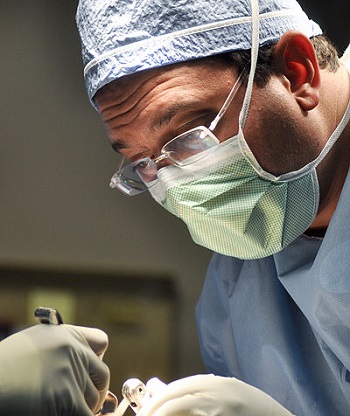A surgeon in the United Kingdom, Shafi Ahmed, will be conducting the procedure to be viewed with a VR headset.
A cancer patient in the U.K. will be undergoing surgery on April 14 at 1p.m. local time, and the surgeon, Dr. Shafi Ahmed, will be using virtual reality technology linked to a mobile phone in order to be able to let others experience the live-stream of the entire procedure.
This will allow the surgery to be viewed by people around the world, as though seeing it from a massive operating theater.
The surgeon has been among those at the very head of pioneering virtual reality technology for the purposes of using it in surgery. He believes that the upcoming VR streamed surgery will be a game changer when it comes to medical education and health care innovation. The patient who will be undergoing the surgery currently has colon cancer. He is a man in his 70s and is not being identified by name, but he has said that he is quite excited about the thought that an international medical community will be viewing his procedure.
The operation will be viewable through the use of virtual reality technology headsets at Royal London hospital.
 The operation will be filmed through the use of a number of different specialist cameras that will be positioned above the operating table. It is expected that the surgery will continue for two to three hours. The streaming of the surgery will run at a lag of about a minute behind the procedure itself, in case any unforeseen complications should occur.
The operation will be filmed through the use of a number of different specialist cameras that will be positioned above the operating table. It is expected that the surgery will continue for two to three hours. The streaming of the surgery will run at a lag of about a minute behind the procedure itself, in case any unforeseen complications should occur.
The use of VR technology could be a very promising experience for trainee physicians who have traditionally needed to try to stand out of the way of the actual surgeons while essentially trying to see over their shoulders. In this case, they will be able to wear headsets and see exactly what is going on, as though they are right there in the operating room with the best possible viewing position. It will also be possible for them to change their viewing angle in order to get a better look at something they wish to see.
Dr. Ahmed discussed the virtual reality technology live streaming of the surgery and explained that “It showcases virtual reality for what it should be used for – education.”
Smartwatches and fitness bands are becoming more commonplace and may help to create smarter cars.
Wearable technology is becoming extremely popular, particularly when it comes to various types of health and fitness trackers, though smartwatches are slowly on their way in, as well. Ford hasn’t failed to notice this.
Moreover, Ford has not failed to notice the opportunity that wearables could present for its vehicles.
Scientists and engineers working for the automaker are currently looking into ways to integrate wearable technology and vehicles in order to improve driver assist technologies in a way that is much more customized to the unique experience of the driver who is behind the wheel. Of particular interest to the researchers is the detection of a stressed or sleepy driver and ways to help to promote a safer road experience as a result of the awareness of those conditions.
The Ford Research and Innovation Center researchers think wearable technology could bring vital health data to auto tech.
 This could allow information about the condition of the driver to be shared with the in-vehicle technologies, such as the Blind Spot Information System and lane-keeping assist. For instance, Ford described a way in which wearables could be integrated into lane-keeping assist by causing the system to become more sensitive if it should detect that the driver had not received adequate sleep during the night before.
This could allow information about the condition of the driver to be shared with the in-vehicle technologies, such as the Blind Spot Information System and lane-keeping assist. For instance, Ford described a way in which wearables could be integrated into lane-keeping assist by causing the system to become more sensitive if it should detect that the driver had not received adequate sleep during the night before.
Connection to a health tracker could also work with the adaptive cruise control if a driver’s heart rate spikes with an increase of traffic, as it could encourage the vehicle to boost the distance between itself and the other vehicles around it. This could provide the driver with more breathing room and reaction time in order to decrease stress levels and raise road safety.
According to the vehicle design and infotronics global manager at Ford Research and Advanced Engineering, Gary Strumolo, “Wearable technology integrated with the vehicle allows for more accurate biometric data to stream continuously and alert active driver-assist systems to become more sensitive if the driver shows signs of compromised health or awareness.” It will be interesting to see how such technology fares in safety testing when it comes time to release it.
 The operation will be filmed through the use of a number of different specialist cameras that will be positioned above the operating table. It is expected that the surgery will continue for two to three hours. The streaming of the surgery will run at a lag of about a minute behind the procedure itself, in case any unforeseen complications should occur.
The operation will be filmed through the use of a number of different specialist cameras that will be positioned above the operating table. It is expected that the surgery will continue for two to three hours. The streaming of the surgery will run at a lag of about a minute behind the procedure itself, in case any unforeseen complications should occur.
 This could allow information about the condition of the driver to be shared with the in-vehicle
This could allow information about the condition of the driver to be shared with the in-vehicle 